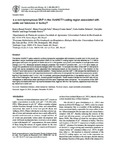Por favor, use este identificador para citar o enlazar este ítem:
http://www.alice.cnptia.embrapa.br/alice/handle/doc/1072285Registro completo de metadatos
| Campo DC | Valor | Lengua/Idioma |
|---|---|---|
| dc.contributor.author | FERREIRA, J. R. | pt_BR |
| dc.contributor.author | FARIA, B. F. | pt_BR |
| dc.contributor.author | JUNIOR, M. C. | pt_BR |
| dc.contributor.author | DELATORRE, C. A. | pt_BR |
| dc.contributor.author | MINELLA, E. | pt_BR |
| dc.contributor.author | PEREIRA, J. F. | pt_BR |
| dc.date.accessioned | 2017-07-07T11:11:11Z | pt_BR |
| dc.date.available | 2017-07-07T11:11:11Z | pt_BR |
| dc.date.created | 2017-07-07 | pt_BR |
| dc.date.issued | 2017 | pt_BR |
| dc.identifier.citation | Genetics and Molecular Biology, v. 40, n. 2, p. 480-490, 2017. | pt_BR |
| dc.identifier.uri | http://www.alice.cnptia.embrapa.br/alice/handle/doc/1072285 | pt_BR |
| dc.description | The barley HvAACT1 gene codes for a citrate transporter associated with tolerance to acidic soil. In this report, we describe a single nucleotide polymorphism (SNP) in the HvAACT1 coding region that was detected as T-1,198 (in genotypes with lower root growth on acidic soil) or G-1,198 (greater root growth) and resulted in a single amino acid change (L/V-172). Molecular dynamic analysis predicted that HvAACT1 proteins with L or V-172 were stable, although the substitution led to structural changes within the protein. To evaluate the effect of the SNP on tolerance to acidic soil, barley accessions were separated into haplotypes based on the presence of a 1 kb insertion in the HvAACT1 promoter and a 21 bp insertion/deletion. These markers and the SNP-1,198 allowed the identification of five haplotypes. Short-term soil experiments showed no difference in root growth for most of the accessions containing the 21 bp insertion and T or G-1,198. In contrast, genotypes showing both the 21 bp deletion and G-1,198, with one of them having the 1 kb insertion, showed greater root growth. These results indicate that the SNP was not advantageous or deleterious when genotypes from the same haplotype were compared. The occurrence of the SNP was highly correlated with the 21 bp insertion/deletion that, together with the 1 kb insertion, explained most of the barley tolerance to acidic soil. | pt_BR |
| dc.language.iso | eng | eng |
| dc.rights | openAccess | eng |
| dc.subject | Aluminium tolerance | pt_BR |
| dc.subject | Citrate transporter | pt_BR |
| dc.subject | Haplotype | pt_BR |
| dc.title | Is a non-synonymous SNP in the HvAACT1 coding region associated with acidic soil tolerance in barley? | pt_BR |
| dc.type | Artigo de periódico | pt_BR |
| dc.date.updated | 2017-07-07T11:11:11Z | pt_BR |
| dc.subject.thesagro | Hordeum Vulgare | pt_BR |
| dc.subject.nalthesaurus | single nucleotide polymorphism | pt_BR |
| riaa.ainfo.id | 1072285 | pt_BR |
| riaa.ainfo.lastupdate | 2017-07-07 | pt_BR |
| dc.contributor.institution | Jéssica Rosset Ferreira, Universidade Federal do Rio Grande do Sul; Bruna Franciele Faria, Universidade Federal de São João Del Rei; Moacyr Comar Junior, Universidade Federal de São João Del Rei; Carla Andréa Delatorre, Universidade Federal do Rio Grande do Sul; EUCLYDES MINELLA, CNPT; JORGE FERNANDO PEREIRA, CNPGL. | pt_BR |
| Aparece en las colecciones: | Artigo em periódico indexado (CNPGL)  | |
Ficheros en este ítem:
| Fichero | Descripción | Tamaño | Formato | |
|---|---|---|---|---|
| Cnpgl2017GenMolBiolFerreiraIs.pdf | 3,1 MB | Adobe PDF |  Visualizar/Abrir |









